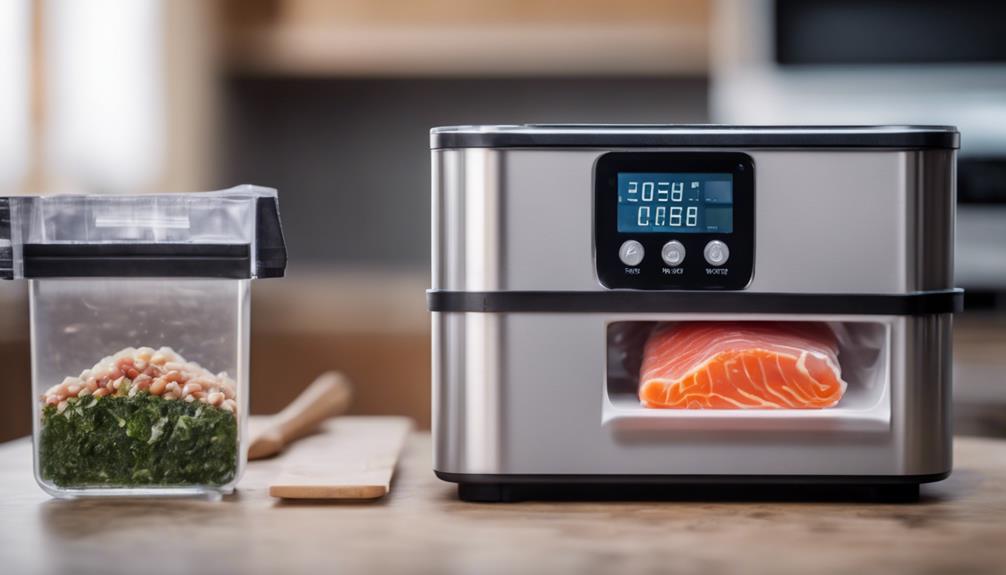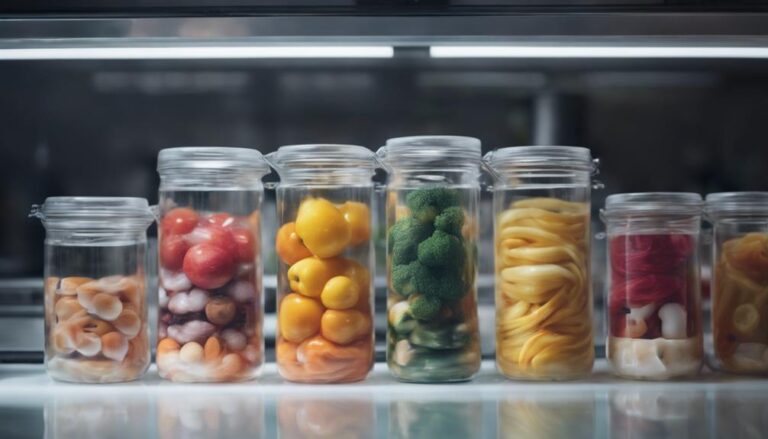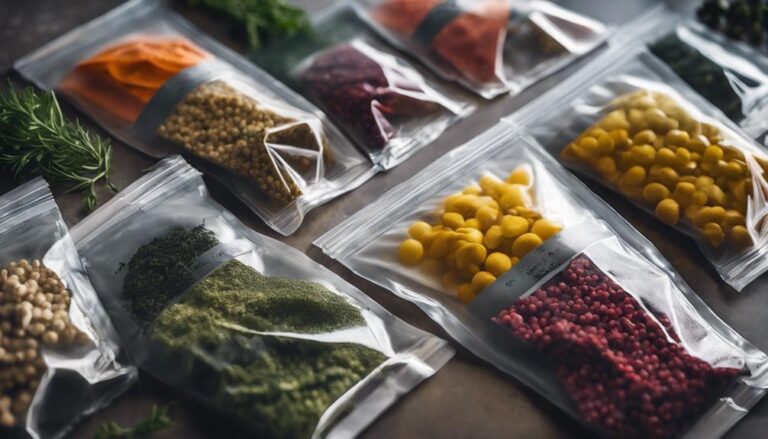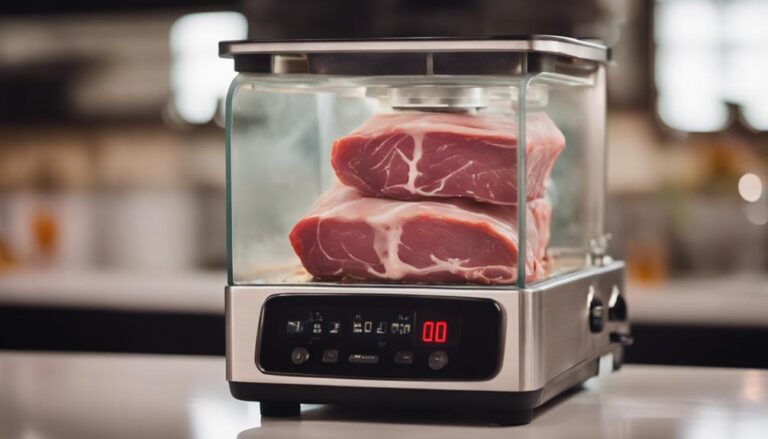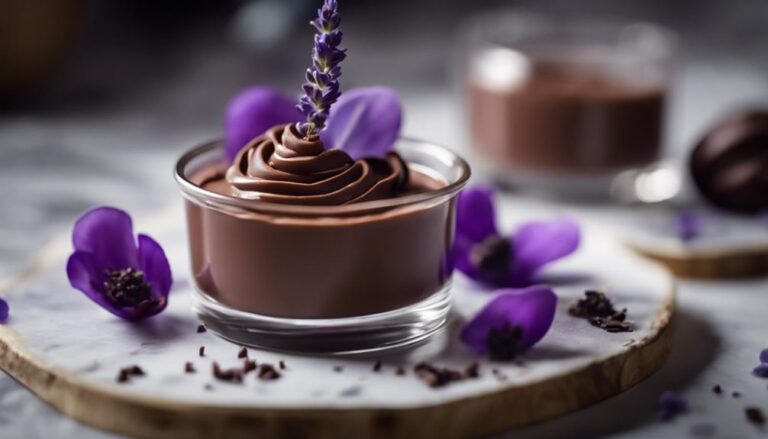Sous Vide Cooking Times and Temperatures: A Beginners Cheat Sheet
Mastering sous vide cooking is easy with this cheat sheet. Set beef at 130°F for medium-rare perfection. Chicken cooks tenderly at 140°F. Pork chops shine at 140°F. Fish stays flaky at 122°F. Lamb chops turn out tender at 134°F. For veggies, aim for ideal texture and flavor. Asparagus is best at 183°F, while carrots stay firm. Troubleshoot issues like water in bags and inconsistent temps. Follow these tips to nail sous vide every time! Want to achieve culinary excellence effortlessly?
What You Will Learn Here
- Refer to recommended temperatures for meats and vegetables.
- Use precise temperature control for perfect results.
- Avoid common sous vide issues with troubleshooting tips.
- Equip with necessary equipment and safety precautions.
- Achieve ideal texture and flavor through accurate cooking times.
Benefits of Sous Vide Cooking
Sous vide cooking offers precise temperature control for consistently perfect results every time. When cooking sous vide, you can achieve consistent and even cooking, whether you're preparing meats or vegetables. This method is a game-changer as it helps retain the natural flavors, juices, and nutrients within your ingredients. Say goodbye to overcooking mishaps – sous vide minimizes this risk, ensuring your dishes come out tender and flavorful every time.
For beginners venturing into the world of cooking, sous vide is a fantastic starting point. It's not just about making delicious meals; it's also a way to elevate your culinary skills. The precise temperature control allows you to experiment with different recipes confidently. Imagine serving your loved ones perfectly cooked, tender dishes bursting with flavor – that's the magic of sous vide cooking. So, whether you're new to the kitchen or a seasoned chef, sous vide can take your dishes to the next level.
Equipment Needed for Sous Vide
You'll need essential gear like a sous vide machine, vacuum sealer, and sous vide bags for successful sous vide cooking.
To guarantee accuracy, a dependable digital thermometer is essential to monitor water temperature accurately.
Don't forget accessories such as sous vide weights and racks to keep your food submerged and a kitchen torch for that perfect sear.
Essential Sous Vide Gear
Investing in the essential gear required for sous vide cooking is important to achieving precise temperature control and consistent results. Here are some key items you'll need for successful sous vide cooking:
| Equipment | Description |
|---|---|
| Sous Vide Machine | Regulates water temperature for precise cooking. |
| Vacuum Sealer | Removes air from bags to guarantee proper cooking. |
| Sous Vide Bags | Heat-safe bags for cooking ingredients. |
| Container | Vessel for water bath cooking. |
| Sous Vide Weights | Keep bags submerged for even cooking. |
| Lid | Helps retain heat during the cooking process. |
| Digital Thermometer | Ensures accurate temperature readings. |
| Tongs | For handling food safely. |
| Kitchen Torch | Used for searing meats post-cooking. |
| Sous Vide Accessories | Enhance the sous vide cooking experience. |
Recommended Accessories
For optimal sous vide cooking results, equipping yourself with the right accessories is crucial to enhance your culinary experience. Make sure you have a vacuum sealer to properly seal your ingredients in sous vide bags for airtight cooking.
A dependable sous vide precision cooker will help maintain accurate temperatures throughout the cooking process. Invest in a sous vide container with a lid to facilitate water circulation and organization, along with a sous vide rack for even cooking. Use sous vide weights or clips to keep your food submerged in the water bath.
A digital kitchen scale is useful for precise ingredient measurements. Additionally, consider using sous vide insulation balls to help maintain water temperature and minimize evaporation during longer cooking sessions.
Safety Precautions to Consider
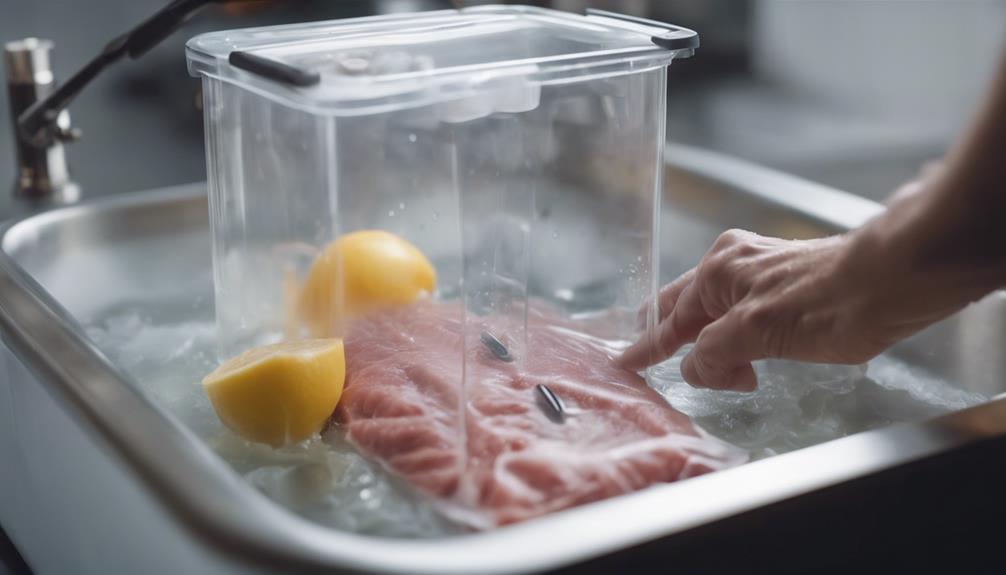
When cooking sous vide, make sure to equip yourself with the necessary safety gear and practice proper handling techniques.
Ensuring that you have the right tools and knowledge will help prevent accidents and injuries.
Prioritize safety at all times to enjoy a worry-free cooking experience.
Safety Gear Essentials
To guarantee your safety while cooking sous vide, always have the essential safety gear on hand.
Use heat-resistant gloves when handling hot sous vide bags or containers to prevent burns. Safety goggles are vital to shield your eyes from steam or splashing hot water.
A sous vide rack helps keep bags submerged and guarantees even cooking, reducing the risk of accidents. Silicone tongs are necessary for safely handling hot bags from the water bath.
Consider using a sous vide container with a lid to minimize steam exposure and prevent mishaps. These beginner-friendly safety gear essentials will help you cook sous vide with confidence and peace of mind.
Proper Handling Techniques
Maintain your cooking environment remains safe and hygienic by following these proper handling techniques:
- Hand Hygiene: Always wash your hands before and after handling food to prevent cross-contamination and guarantee food safety.
- Cutting Boards: Use separate cutting boards for raw meats and cooked foods to avoid contamination.
- Fridge Storage: Store raw meats at the bottom of the fridge to prevent juices from dripping onto other foods and causing contamination.
- Thawing: Thaw frozen foods in the refrigerator or under cold water, not at room temperature, to prevent bacterial growth and ensure proper food safety.
Recommended Temperatures for Meats
For best results in sous vide cooking, set specific temperatures for different types of meats to achieve desired doneness levels. When preparing beef, aim for a medium-rare steak by setting the sous vide temperature to 130°F (54°C) and cooking for 1 to 4 hours, depending on thickness.
If you're cooking chicken breasts, maintain tenderness and juiciness by cooking them at 140°F (60°C) for 1.5 to 4 hours. Pork chops come out succulent when cooked at 140°F (60°C) for 1.5 to 4 hours.
For flaky fish, set the sous vide temperature to 122°F (50°C) and cook for 30 minutes to 1 hour. Lamb chops can be tender and flavorful when cooked at 134°F (56.5°C) for 1.5 to 4 hours.
Recommended Temperatures for Vegetables
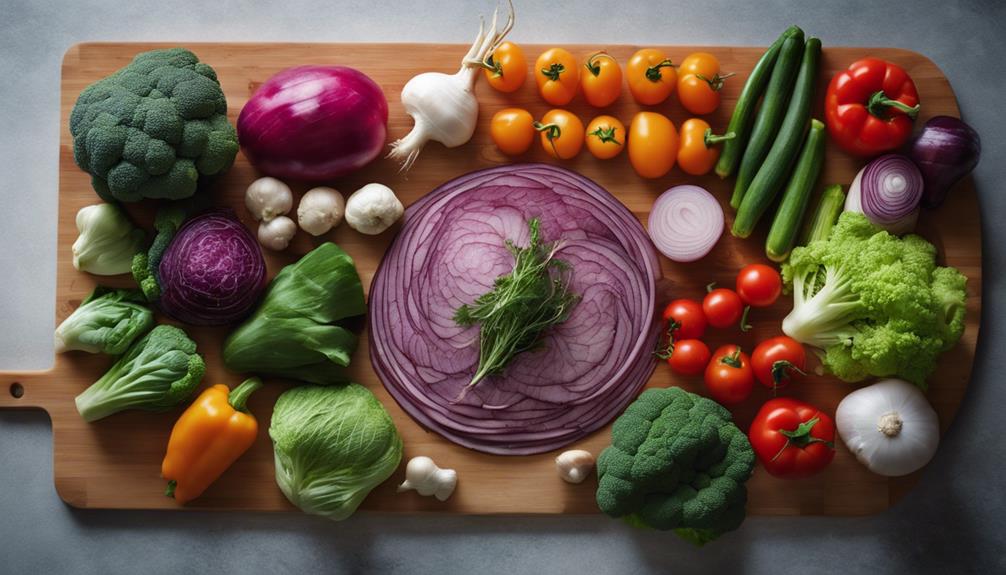
Achieve ideal texture and flavor when cooking vegetables sous vide by setting specific temperatures for each type. Here are the recommended temperatures for popular vegetables:
- Asparagus: Cook sous vide at 183°F for 20-30 minutes for a tender yet crisp texture.
- Carrots: Sous vide at 183°F for 60 minutes to maintain a firm texture with enhanced flavor.
- Broccoli: Achieve a vibrant color and tender-crisp texture by cooking sous vide at 185°F for 30-40 minutes.
- Green Beans: Cook sous vide at 183°F for 20-30 minutes to retain nutrients and a bright green color.
Cooking Times for Different Proteins
Cook your proteins to perfection with precise cooking times for each type using the sous vide method. Here's a handy guide to help you achieve delicious results:
| Protein | Temperature & Time |
|---|---|
| Beef | Medium-rare steak at 129°F for 1-4 hours |
| Chicken | Chicken breasts at 140°F for 1-4 hours; thighs at 165°F for 1-4 hours |
| Pork | Pork tenderloin at 140°F for 2-4 hours; pork chops at 140°F for 1-4 hours |
| Fish | Salmon at 122°F for 30-60 minutes; halibut at 126°F for 45 minutes |
| Lamb | Lamb chops at 140°F for 1-4 hours |
Tips for Successful Sous Vide Cooking
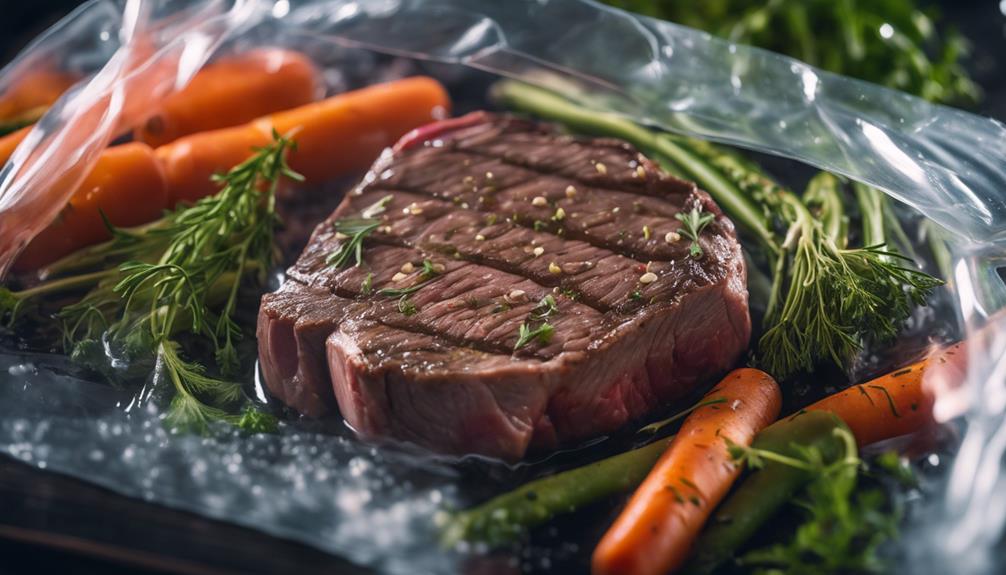
Guarantee your water bath is preheated to the correct temperature for your ingredients to set the stage for successful sous vide cooking. To guarantee a smooth and flavorful sous vide experience, consider the following tips:
- Use High-Quality Ingredients: Start with the best ingredients possible to achieve superior results.
- Monitor Cooking Time: Keep a close eye on the recommended cooking times for different foods to achieve the perfect doneness.
- Quick Sear Finishing: After sous vide cooking, give your dish a quick sear or finish it in other ways to enhance flavors and textures.
- Vacuum Sealed Bags: Utilize vacuum-sealed bags to maintain the integrity of your food and prevent flavor loss during cooking.
Troubleshooting Common Sous Vide Issues
To troubleshoot common sous vide issues effectively, make sure your vacuum sealing is done properly to prevent water from entering the bag during cooking. Checking the water level in the sous vide container regularly is essential to maintaining a consistent temperature throughout the cooking process. It is important to use a reliable sous vide machine with accurate temperature control to avoid undercooking or overcooking your food. Monitor cooking times closely to prevent food from becoming mushy or overcooked; experimenting with different sous vide cooking temperatures and times can help you find the perfect balance for your desired results.
| Common Sous Vide Issues | Troubleshooting Tips |
|---|---|
| Water entering the bag during cooking | Ensure proper vacuum sealing |
| Inconsistent temperature | Check water level regularly |
| Under or overcooking | Use a reliable sous vide machine |
| Mushy or overcooked food | Monitor cooking times closely |
| Desired results not achieved | Experiment with different temperatures and times |
Frequently Asked Questions
At What Temperature Do You Start a Sous Vide?
When starting sous vide, begin at 130°F to 140°F for safety and quality. Adjust for chicken, veggies, seafood, pork, eggs, desserts, sauces, fruits, cocktails, and grains. Remember to preheat water bath first for best results.
How Do I Know How Long to Cook Sous Vide?
To know how long to cook sous vide, consider the thickness and type of food, follow recommended charts, and adjust for personal preferences. Guarantee safety by maintaining precise temperatures. Sous vide offers control, tenderness, and flavor infusion.
What Is the First Thing I Should Sous Vide?
For your first sous vide experience, try cooking simple proteins like chicken breasts or pork chops. They're easy to cook and help you get familiar with the process. Start with these, then explore more recipes and ingredients.
Can You Sous Vide Steak at 110 Degrees?
Yes, you can cook steak sous vide at 110 degrees, but it's not advised for safety. It's crucial to adhere to USDA guidelines for a minimum internal temperature of 145 degrees to make certain harmful bacteria are effectively eliminated.
Conclusion
Now that you have the basics of sous vide cooking down, you're ready to explore the endless possibilities this cooking method offers.
Remember to always prioritize safety, follow recommended temperatures and cooking times, and don't be afraid to experiment with different ingredients and flavors.
With practice and patience, you'll soon be creating restaurant-quality dishes in the comfort of your own home.
Happy cooking!
